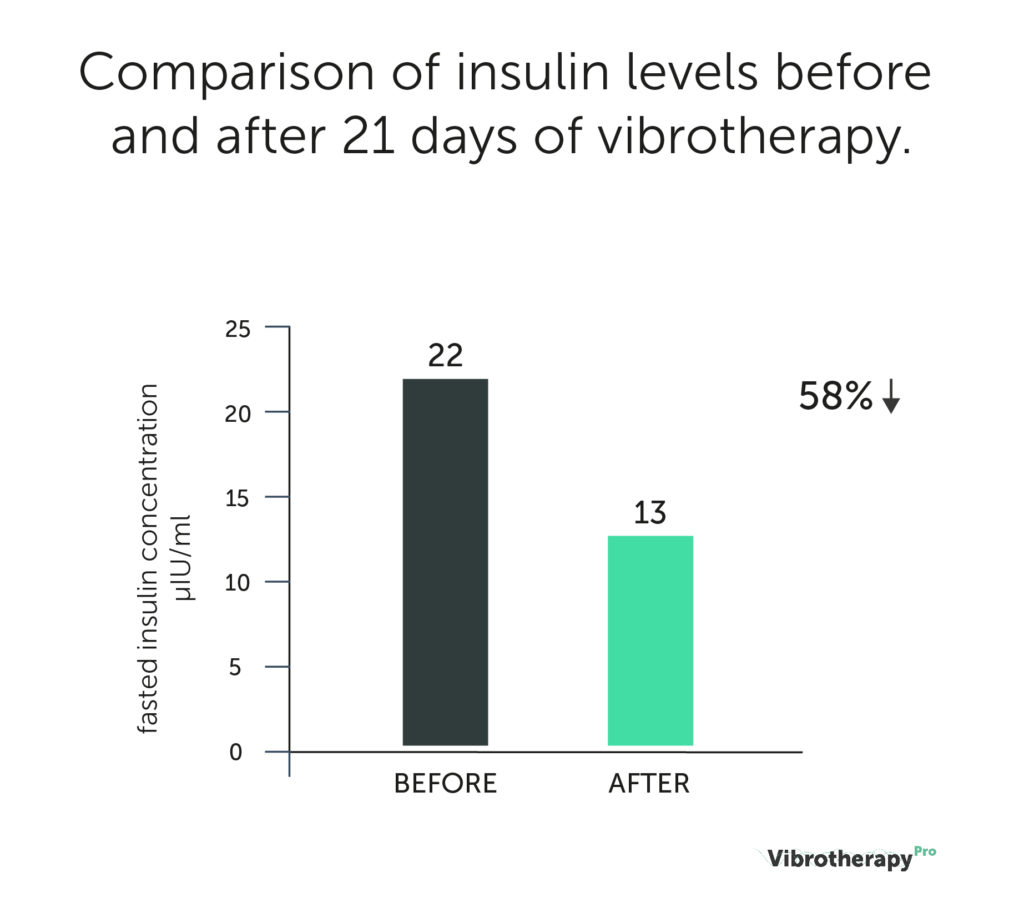Vibration therapy regulates the glucose and insulin levels in people with pre-diabetes
Vibrotherapy used in the prone position for 21 days (2 treatments a day) with RAM Vitberg+ {now updated to Vitberg RS; editorial note} is a promising method to improve glycemic control. Research carried out at the PWSZ (Nowy Sącz, Poland) showed a positive effect of vibration therapy on insulin resistance in people at the risk of developing diabetes. In the group of subjects treated with vibrotherapy, a decrease in fasting insulin concentration was observed, therefore the HOMA-IR and HOMA%B indexes (insulin sensitivity indexes) also improved.
The aim of the study was to evaluate the effect of a series of 21 vibrotherapy treatments on the level of carbohydrate metabolism indices in women over 55 with a history of fasting hyperglycemia.
- 21-hour vibrotherapy (1 hour per day) showed an average decrease in insulin concentration by 58% (from 21.9 ± 11.2 μIU/ml to 12.8 ± 2.7 μIU/ml).
- The study showed a significant reduction in the HOMA-IR (from 2.69 ± 1.41 to 1.93 ± 0.65) and HOMA% B (from 143.69 ± 60.57 to 125.80 ± 52.28) – insulin resistance indexes.
- The HOMA%S value increased (from 48.82 ± 28.57 to 56.33 ± 20.44), which indicates a better insulin sensitivity.
Prepared on the basis of:

Effect of vibration therapy on fasting glucose, insulin level and homa2 score in women with pre-diabetes history. Piotrowska Anna, Tota Łukasz, Czerwińska Olga, Bigosińska Monika et al. Antropomotoryka Journal of Kinesiology and Exercise Sciences. JKES 81(28):11-19, 2018.
Study population
The study included a group of women over 55 with a history of hyperglycemia episodes, randomly assigned to the following groups: experimental (n = 25) and control (n = 25).
Test procedure
Before starting the experiment, a medical qualification was carried out. The volunteers kept food diaries for 5 days (including one Christmas), which were then analyzed using the Diet 5 program (IŻŻ Warszawa). On this basis, the nutritional value of consumed meals was established. The subjects were asked not to change their eating habits during the project. The level of physical activity was assessed using the international physical activity questionnaire (IPAQ – short form). Women with moderate and low levels of physical activity were qualified for the study. Using the GE Healtcare Lunar Prodigy densitometer (USA) and the dual-energy X-ray absorptiometry (DEXA) method, the body weight, percentage and mass of adipose tissue, lean body mass and bone mass were examined. Before the start of the series of 21 treatments (1 per day) and after the 10th and 21st treatment, venous blood samples were collected from a vein at the flexion of the elbow joint. Fasting glucose and insulin levels as well as complete blood count were measured in all patients. The HOMA2-IR, HOMA%B and HOMA%S coefficients were also calculated for each patient.
Use of vibration in the study
Single vibrotherapy treatment was performed using RAM Vitberg+ (medical device of class IIa; Vitberg, Nowy Sącz, Poland) with vibration frequency of 20-52 Hz, amplitude 0.1-0.5 mm, 2×30 minutes. All patients from the experimental group received 21 treatments. The identical treatment regime was performed in the control group, but with the use of specially prepared placebo version of RAM Vitberg+ with relevantly modified actuators.
Results
Women with a history of hyperglycemia were invited to the project, but their glucose levels could not constitute full-blown diabetes (this is diagnosed with at least two random blood glucose levels ≥ 11.1 mmol/L or fasting blood glucose levels ≥ 7.0 mmol/L). Initial studies showed that participants in both groups had mean blood glucose levels: 5.73 ± 0.41 mmol/L (experimental group) or 5.64 ± 0.51 mmol/L (control group) and mean insulin levels: 21.9 ± 11.2 μIU/ml (experimental group) or 20.5 ± 9.1 μIU/ml (control group). There was no statistically significant difference between the groups. On the 10th day of the experiment (after 10 treatments), these values for the experimental and control groups still remained at similar levels (respectively: 5.78 ± 0.48 or 5.61 ± 0.46 mmol/l for glucose; for insulin: 18.4 ± 8,9 or 20.2 ± 14.4 μIU/ml).
A statistically significant decrease in fasting insulin was observed at the end of the study (from 21.9 ± 11.2 μIU/ml to 12.8 ± 2.7 μIU/ml). This change took place after 21 treatments, which confirms earlier reports about the need for repeated and regular use of vibration treatments in order to generate changes in biochemical indicators in the blood.

Comment
Insulin binds to its receptors on the fibers of skeletal muscle and allows glucose molecules to be transported inside the cell causing the concentration of glucose in the blood to be lowered. Chronic hyperinsulinemia (too much insulin) has the opposite effect, leading to insulin resistance, which is the basis for the development of type II diabetes. In the light of this information, the decrease in fasting insulinemia caused by regular vibrotherapy training observed in the present study can suggest vibrotherapy to be considered as an effective form of antidiabetic prophylaxis.
More in:

